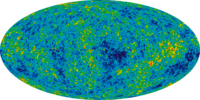
Photo from wikipedia
Ionizing photons escape a lensed galaxy Young, hot stars emit ultraviolet radiation, which can ionize a neutral gas. The first generation of stars converted most of the intergalactic gas in… Click to show full abstract
Ionizing photons escape a lensed galaxy Young, hot stars emit ultraviolet radiation, which can ionize a neutral gas. The first generation of stars converted most of the intergalactic gas in the Universe from neutral to ionized form during the epoch of reionization less than a billion years after the Big Bang. Rivera-Thorsen et al. took advantage of a gravitational lensing system to observe 12 images of the same star-forming region in a distant galaxy and determined the fraction of ultraviolet photons that escape into the intergalactic medium. Although this galaxy is younger than the epoch of reionization, the results provide clues about how ultraviolet photons escape their host galaxies and contribute to the reionization process. Science, this issue p. 738 Viewing the same galaxy from different angles demonstrates that ultraviolet photons escape through gaps in clumpy gas. During the epoch of reionization, neutral gas in the early Universe was ionized by hard ultraviolet radiation emitted by young stars in the first galaxies. To do so, ionizing ultraviolet photons must escape from the host galaxy. We present Hubble Space Telescope observations of the gravitationally lensed post-reionization galaxy PSZ1-ARC G311.6602–18.4624 (nicknamed the “Sunburst Arc”), revealing bright, multiply imaged ionizing photon escape from a compact star-forming region through a narrow channel in an optically thick gas. The gravitational lensing magnification shows how ionizing photons escape this galaxy, contributing to the reionization of the Universe. The multiple sight lines to the source probe absorption by intergalactic neutral hydrogen on a scale of less than a few hundred parsecs.
Journal Title: Science
Year Published: 2019
Link to full text (if available)
Share on Social Media: Sign Up to like & get
recommendations!